ZEN MESTEREK ZEN MASTERS
« Zen főoldal
« vissza a Terebess Online nyitólapjára
蜆子和尚 Xianzi heshang
(Rōmaji:) Kensu oshō
(English:) Clam Priest
(Magyar:) Hszien-ce,
a Rákász mester
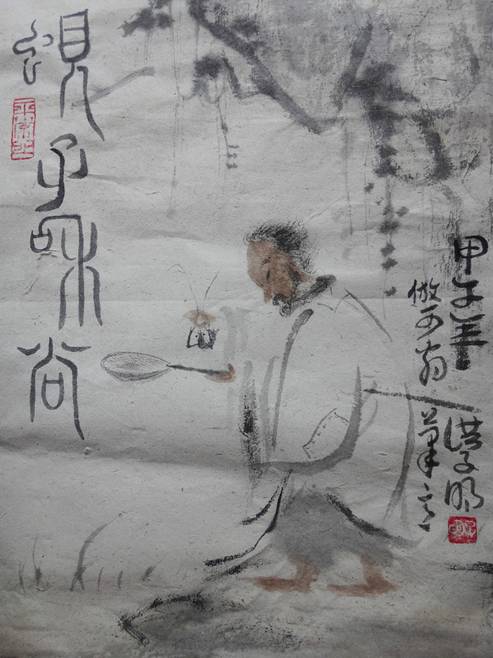
Painting by 洪子明 Hong Ziming (1953-)
Kensu 蜆子
Ch: Xianzi. A semi-legendary 9c itinerant priest and eccentric. His name, meaning something like "Clam Priest," is derived from his practice of spending his days wandering along river-banks eating crayfish and clams. Although this practice is in conflict with the Zen 禅 (Ch: Chan) insistence on a strictly vegetarian diet, one story has it that Kensu achieved enlightenment while catching a shrimp. However, eccentrics who disobeyed Buddhist law to follow their own natures were often greatly respected. The earliest description of Kensu is found in the Record of The Transmission of The Lamp (Jp: KEITOKU DENTOUROKU 景徳伝灯録, Ch: Jingde Chuandenglu) of 1004 which lists him as a disciple of priest Dongshan (Jp: Dousan 洞山; 807-69), one of the founders of the Soutou 曹洞 sect of Zen. Some scholars, however, are wary of this claim, and feel Kensu had no firm affiliation with an established order. Kensu reportedly lived near the White Horse Temple (Ch: Baimasi 白馬寺) on Mt. Dong 東. In painting, he is usually depicted wearing ragged clothes, holding a crayfish in one hand and a net in the other. Images of Kensu are frequently paired with Zen eccentric Chotou 猪頭, who is always represented carrying a boar's head. Typically, Kensu's hair is long and sparse and he bears a beatific grin. Among the best-known paintings of the subject are: those attributed to Muqi (Jp: Mokkei 牧谿, Private collection in Japan); by Kaou 可翁 (act. mid-14c.; Tokyo National Museum); and Hasegawa Touhaku 長谷川等伯 (1539-1610; Daitokuji Shinjuan 大徳寺真珠庵, Kyoto).
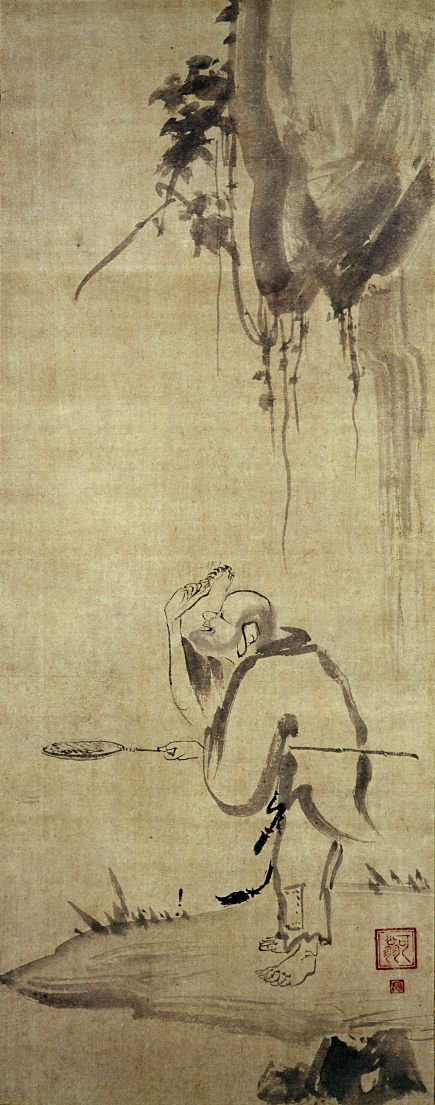
蜆子和尚図 by Kaō Sōnen 可翁宗然
Priest Xian-zi catching shrimp (Kensu oshō-zu)
87.0 x 34.5 cm
Nanbokucho period, 14th century
Tokyo National Museum
Important Cultural Property
http://www.tnm.jp/modules/r_collection/index.php?controller=dtl&colid=A10931
According to an early eleventh-century
source, the Chinese Chan monk Xianzi
studied under Dongshan Liangjie (807-
869), the founder of the Caodong (Jap.
Soto) school. It is said that Xianzi did not
have any permanent residence, and that
he liked to keep the company of the people
in the streets. For his daily living
requirements, he fished for shrimp, ebi,
and a kind of mussels, shijimi, in the
nearby lakes and rivers.
In this painting "Reverend Prawn Fisher",
Kensu Oshc, is standing on a narrow strip
of land below an overhanging rock from
which dangle branches and vines. He is
barefoot; under his loose upper garment
he wears a ragged, mended pair of pants
held together by a black cord. With his left
arm he holds a long bamboo pole to which
the catching net is attached. He has just
caught a shrimp and is holding it aloft with
his right hand in joyous and grateful triumph.
The bald-headed old shrimp catcher symbolizes
the unadulterated, natural joy of
life and spontaneity characterizing the Zen
spirit freed from all clerical conventions.
For this untrammeled Zen master, everyday
life itself is already a religious exercise.
Everywhere, the phenomena of this world
offer him countless possibilities to strive
after his final goal, i.e., enlightenment.
In the sound composition of the painting,
the overhanging cliff, the dangling vines,
and the central figure of the shrimp
catcher emphasize the vertical axis. The
horizontal bamboo pole, the sandy shore,
and the suggested water surface form the
harmonious balance to these vertical elements.
The lower right corner of the painting
bears two red seals. The upper, square
relief seal shows the name of the artist,
Ka'o. The small seal below is usually read
Ninga. None of the accepted paintings by
Ka'o bears any inscriptions.
The high quality and the unmistakable Zen
spirit of his paintings, however, have led
scholars to believe that the artist was the
high-ranking Zen monk Ka'o Sbnen. At
first Sbnen studied under Nanpo Jbmin
(1235-1308) at Kenchbji in Kamakura. In
1319, he travelled to Yuan China with a
group of renowned Japanese Zen monks,
returning only seven years later, on the
same boat as Qingzhuo Zhengcheng
(1274-1339) and his confreres. In Kybto,
Ka'o Sbnen was first appointed 16th abbot
of a gozan monastery, the Manjuji;
1343 he became the 28th abbot of
Kenninji; two years later, he was inaugurated
as abbot of Nanzenji. He died on the
24th day of the eighth month in 1345.
Ka'b is one of the earliest representatives
of monochrome ink painting, suibokuga,
in Japan, and thus, together with Moku'an
Rei'en, one of the most important artists
of that period.Zen - masters of meditation in images and writings
by Helmut Brinker [1939–2012]; Hiroshi Kanazawa [金沢 比呂司 1937-]
Museum Rietberg; Artibus Asiae, Zürich, 1996, 222 p.
牧溪法常 Muqi Fachang / Muxi Fachang (c.1210-1269);
Japanese: 牧谿 Mokkei
Master Clam 蜆子和尚
Muxi Fachang 牧谿法常 (13th century) Before 1256, Southern Song (1127-1279)
Encomium by Yanxi Guangwen 偃溪廣聞 (1189-1263)
Hanging scroll, ink on paper, 84.1 x 37.4
Private collection, JapanEncomium:
Casually grasping what comes, dragging the mud and wading the water,
Illicit booty emerges before him, facing a tough taboo,
If the wine of tray is missing from before the gods,
Ultimately he has not cast off the handiwork of demons.Inscribed by Guangwen, resident of the Cold Spring.
信手拈來,拖泥涉水, 贓物現前,當面難諱, 若無神前酒臺盤, 終不 脫 鬼家活計。 住冷泉廣聞題。
Chien-tzu is supposed to have been a disciple of Tung-shan Liang-chieh (807-869). He was not a Ch'an monk in the usual sense, however. Dressed in the same rags in summer and winter, he roamed the riverside with his fishing net in search of shrimps and clams, which formed his staple diet. At night he would sleep among the offerings of paper money made to the White Horse Shrine on Eastern Mountain. It was said that he attained Enlightenment while catching shrimp.
楊月 Yōgetsu (fl. late 15th–early 16th century; active 1485)
http://burkecollection.org/catalogue/98-chot%C5%8D-kensu
http://webarchives.tnm.jp/imgsearch/show/C0006937
蜆子図
Kensu
28.5 x 22.8 cm
Minneapolis Institute of Arts, The Mary Griggs Burke Collection
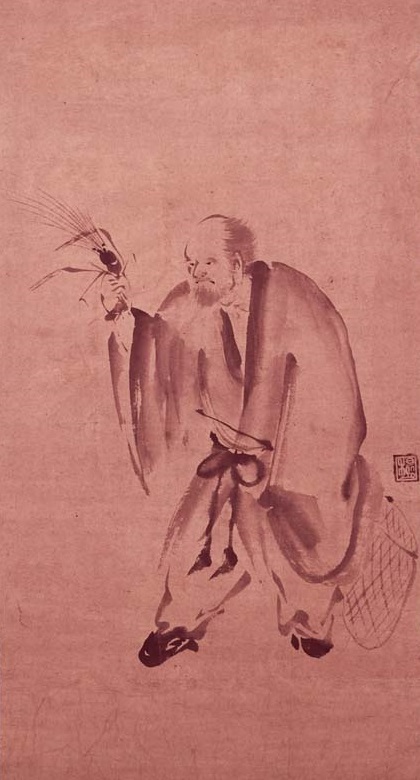
蜆子図
Kensu
90,9 × 33,3 cm
Tokyo National Museum
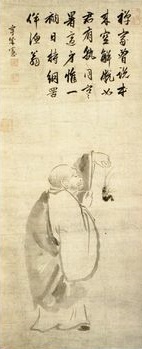
The Monk Kensu (Xianzi)
by Yōgetsu with an inscription by Yu Chengxian
59.9 × 24.7 cm
Sanso Collection
海北友松 Kaihō Yūshō (1533–1615)
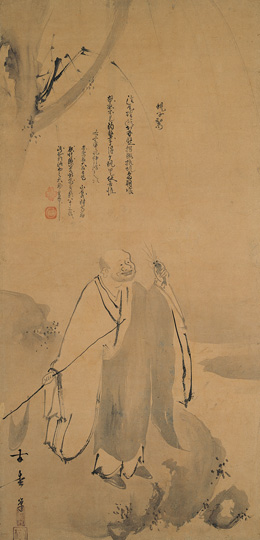
蜆子和尚 (其の七 )
禅宗祖師・散聖図(静岡県立美術館蔵)
1613 (慶長 18 )年
紙本墨画 六曲一双押絵貼屏風
(各図) 107.2 × 51.5cm
本屏風は、各扇 1 面ずつ独立した画を貼り付けた押絵貼形式で 12 図よりなる。達磨大師に始まる禅宗の祖師中、二祖・六祖と中国の高僧、さらに散聖(正当な法系に属さない禅僧)の故事をそれぞれ絵画化している。故事は、一匹の猫をめぐって争う僧徒を戒めるべく、その猫を切断したという中国唐代の名僧、南泉普願(なんせんふがん)の説話(南泉斬猫(ざんみょう))などである。
濃淡の簡略な筆(線)とにじみを生かした墨(面)によって、ふくらみのある人体のフォルムが捉えられている。これは友松が得意としたスタイルで、中国南宋中期( 13 世紀前半)の画院画家として有名な梁楷の減筆体(少ない筆数で人物を的確にとらえ描写)に基づくものである。画面全体の淡い墨調からは心地よい情感が伝わってくる。
友松には、押絵貼による同種の禅宗故事図が他に数例知られるが、本屏風の場合、図上の画賛がとくに重要な意味をもっている。同賛は、京都妙心寺 80 世・静岡臨済寺 4 世を務めた学僧鉄山宗鈍(そうどん)による。鉄山が慶長 18 年( 1613 )、武将山名禅高のために書したもので、同年は友松 81 歳、本図は彼の最晩年の作である。制作依頼者、制作年、制作目的などが判明する貴重な作品といえよう。
狩野探幽 Kano Tan'yū (1602–1674)

蜆子図
Kensu attributed to Kano Tan'yū
Hanging scroll; ink on paper
28.2 x 51.3 cm
Minneapolis Institute of Arts, The Mary Griggs Burke Collection
曾我蕭白 Soga Shōhaku (1730–1781)
蜆子像 Kensu zo
Xianzi (Kensu), the Shrimp Gatherer
114.2 x 50.4 cm
Museum of Fine Arts Boston
仙厓義梵 Sengai Gibon (1750-1837)
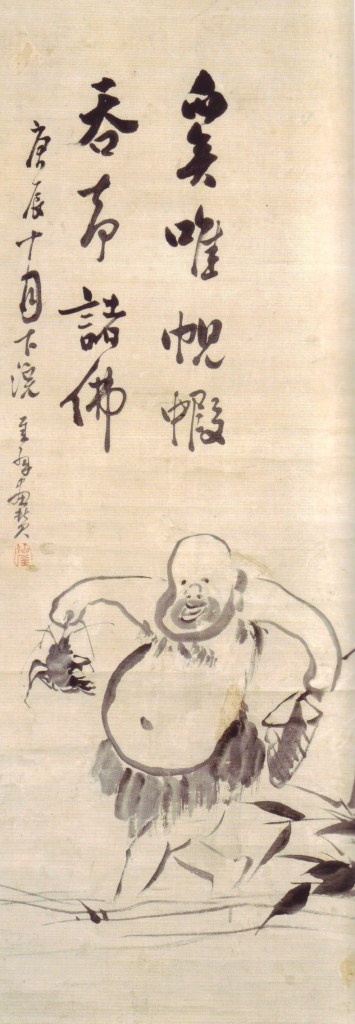
『蜆子和尚図』 “Kensuoshō-zu”
by 仙厓義梵 Sengai Gibon (1750-1837)【絵画データ】
1820 年作
一幅 紙本墨画
101.9cm×70.9cm
収蔵場所 福岡市美術館Kensu-oshō was a Chinese priest of the end of the Tang dynasty to the Five Dynasties period. He was known for his eccentric behavior. With little more than the clothes on his back, he spent his days at riverbanks, digging for clams and catching shrimp as food, while at night he took shelter from the dew by burying himself under the paper money dedicated to small shrines as offerings to the gods and the dead. The design depicts the priest almost comically and is accompanied by words of praise to the effect that although he is an apostate priest who kills living creatures every day, his inner self contains a power that could overtake various Buddha. The artist, Sengai, was a Zen priest of the Rinzai sect, living in Hakata, Kyushu. He is known for his witty and humorous Zen drawings.
永真安信 Eishin Yasunobu (1613-1685)
出山釈迦(しゅうさんしゃか)・猪頭(ちょとう)和尚・蜆子(けんす)和尚図 3 幅 平成 2 年 4 月 6 日指定
|
筆者 狩野永真安信 無賛
|